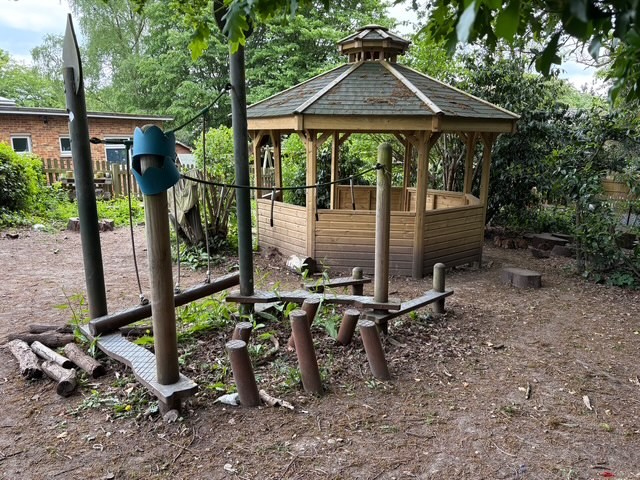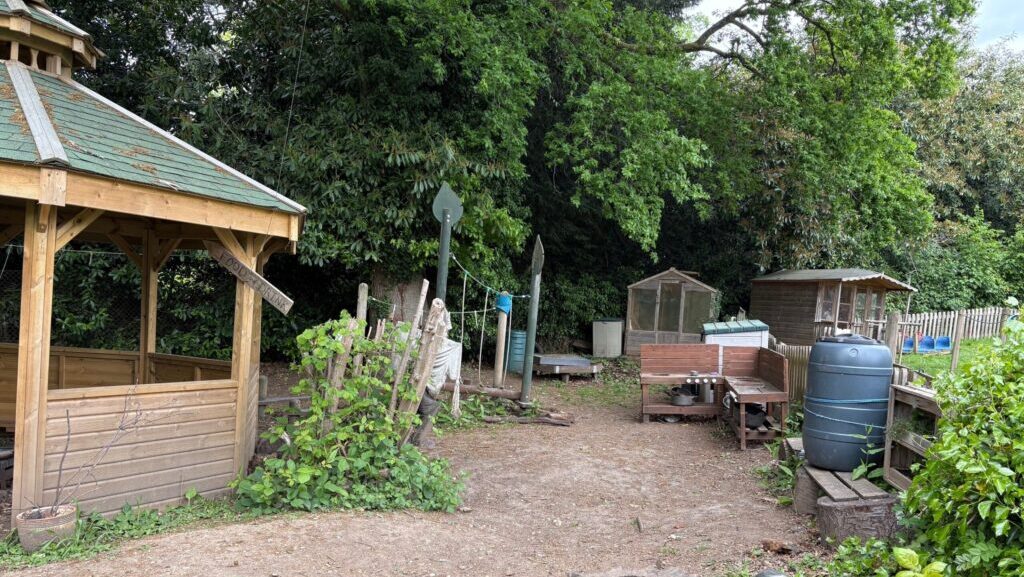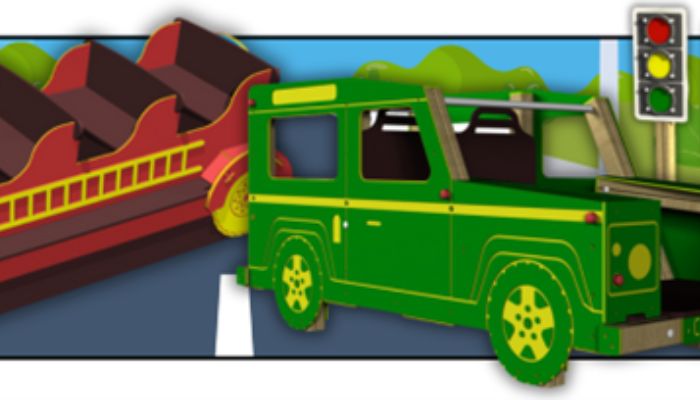We chat to outdoor play expert Claire from Creative Play, who shares how imaginative play can support early years development…
Fresh air – force for good
The government has launched a consultation on how nurseries can make better use of outdoor space for play and learning. Charlotte Goddard finds out how RafaKidz Medmenham transformed its outdoor space

In the forest there is the sound of enthusiastic howling. The children at RafaKidz Medmenham are pretending to be wolves. “They like playing ‘What’s the time Mr Wolf ?’ in here,” explains room leader Joyce Power.
Approaching the nursery, which is located on an RAF base, or station, in Buckinghamshire, there’s little indication of its large outdoor space. However, it quickly becomes apparent that every room in the Outstanding-rated setting has its own garden area, designed around the needs and abilities of that particular age group. In addition, a fenced-off forest area is set aside for every age-group to take part in forest school – including the babies.
“Everyone thinks forest school is for school-age children, but the babies and toddlers love the digging and getting muddy and the puddles,” says deputy manager Sammie Farrar, who joined the nursery as an apprentice 15 years ago but also attended the setting as a service child. “Some of them are non-walkers – that’s fine. We put them on the mud, and as long as they have waterproofs on they are fine.”
The outdoor space didn’t always look like this. Over the past few years nursery manager Amanda Brown has been on an ongoing mission to revamp the whole area, using funding sources including the Armed Forces Covenant Fund. “We have spent about £100,000 on these gardens to transform the space,” says Brown, whose husband serves in the RAF.

RafaKidz Medmenham was previously operated by Spring by Action for Children but was taken over by RafaKidz in 2023. RafaKidz, which currently runs 19 settings, was designed to meet the needs of military and civilian families in the community around an RAF station, providing affordable and quality childcare.
Medmenham also takes in children from civilian families but prioritises spaces for service children. The majority of the 21 staff are also from service families.
In May, the government launched a consultation on whether to include ‘free flow’ outdoor space when calculating the number of children a nursery can look after at one time. Currently, each child under two requires 3.5 square metres, each two-year-old requires 2.5 square metres and children aged three to five, 2.3 square metres.
“We feel lucky that we work for a company that will support us in finding the best way to work with this,” says Farrar.
Forest school
The forest school was created after staff attended forest school training and identified the tree-filled corner as an ideal site. Brown was initially dubious about allowing children to light fires, but now her favourite investment is a fire-retardant wooden shelter, with a chimney which allows fires even when it is raining, and a seated area. The hut cost £9,550 from the Hideout House Company.
“This enables us to stay out a lot longer, even when the weather isn’t good,” she says. “It is one of the best pieces of equipment I have ever bought, I can’t recommend it enough.” Children use a flint and steel fire starter with cotton wool to light fires. They cook toast, pancakes or crumpets over the fire. “We used to have a fire circle with a tarpaulin cover but it kept blowing away, so we persuaded Amanda to invest in this,” says Power.
The two-and-a-half to school age children (Oaks) attend forest school twice a week for half a day, while the 18 months to two-and-a-half-year-olds (Acorns) attend once a week. The babies, known as Bluebells, are being gradually introduced to the area. The setting is working towards running a forest school session every day.
Adventurous behaviour is encouraged but safeguarding is key. Staff do a daily sweep of the area to remove potentially poisonous plants such as ‘lords and ladies’. Children are taught to avoid other plants, such as nettles. “We tell children that is going give you an ouchie,” says Power. “We go through the forest school rules every session.” The rules are “no picky” (don’t pick plants), “no licky” (don’t lick anything), “no going in the fire circle” and “no going out of the gate”.
Children use real tools, including hammers, and knives for whittling. “When they do their whittling they have what we call a ‘blood bubble’,” explains Power. “They put out their arms and that space is their blood bubble, and no one is to walk in that space when they do their whittling.”
Children cover every aspect of the Early Years Foundation Stage while in forest school, including numeracy. “The children are measuring worms with their special worm ruler, they are counting the worms,” says Power.

Nursery staff have noticed the positive impact the forest school has had on children’s behaviour, particularly on those with additional needs. “There are hardly any toys to play with here, so they are playing with each other, they are making up their own games, they are playing with mud and natural stuff,” says Brown.
“If you observe them in the garden, they will be in their own little groups, but here they all play together,” agrees Power, who is also the nursery’s Senco.
Baby garden
Brown has also revamped each age group’s garden area. “I wanted to make sure we are enhancing their development,” she says.
In the Bluebells’ garden, gravel and stone has been replaced by mulch, to support the crawlers. A sensory path, developed by ESP Play, allows the children to explore different surfaces by walking, crawling or riding bikes or trikes across it.
A planting area is set aside for herbs such as lemon balm, as well as fruit and vegetables. “The children enjoyed doing the planting, they come and check the garden every day and they love watering it,” says Farrar. The children incorporate the herbs in their mud kitchen play, while the nursery chef also uses them to prepare meals. “We are teaching children about where food comes from, because if they see food growing, they are more likely to eat it,” says Brown.
Acorns and Oaks
The Acorns garden includes a rainbow hut for children to sit in, which projects colours around with the sunlight. It also had a large mud kitchen area with space for them to dig mud to add to it.
The Oaks children have the largest garden with plenty of space to run around. It incorporates a quieter area with blossoming apple and pear trees, a story chair, friendship benches and planters filled with flowers. “We have found that we have had a lot more children with special educational needs and disabilities in the last four or five years, the ones that were babies during lockdown,” says Brown. “So we developed this area, where children can come and have a quiet time.”
Many nurseries look at wooden equipment thinking it is more sustainable, but Brown believes that this can be a false economy both financially and environmentally. “We started off trying to do everything in wood, but I have gone on to recycled plastic now,” she says. “I want to get things that will last a long time.”
A large recycled plastic channel is the latest addition to the garden, allowing children to swoosh water down, and build dams out of sand. A group of plastic animals are currently standing in it waiting to be washed away by the oncoming flood.
“I have had about three wooden water play systems since I have been here, and every one has broken,” says Brown. “This one is robust and it’s not going anywhere. I’m thinking of getting a bilge pump so the children can pump the water back up.”
The mud kitchen, which cost £891 and is also from Hideout House, is also made of recycled plastic and is similarly sturdy. “This is so heavy five men had to lift it; we had to get parents to come and help us,” says Brown. “It’s never going to rot.”
Oaks children also have access to a covered role play area with a train and, of course, an aeroplane, encouraging children to use their imagination and play together.
The learning doesn’t end when the children leave nursery either. Children are sent home with a weekly challenge taken from the National Trust’s list of ‘50 things to do before you are 11’.
“Parents love it, they want to come to forest school too,” says Brown. “We have one little girl who will play with mud all day, every day. I do apologise to mum when we hand her over all muddy, but she says ‘I can tell she has had a great day, I don’t mind. Let them embrace it’.”
Latest Features
The roll-out of new innovations doesn't always go to plan. Ben Case, education advisor at childhood education platform Tapestry, sets…
Hannah Haines, head of healthcare consultancy at property advisor Christie & Co, provides insights into the key growth and development…




